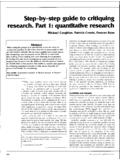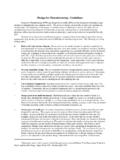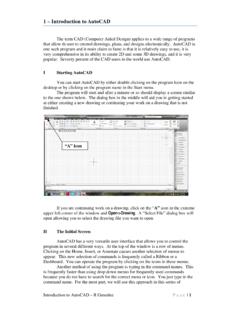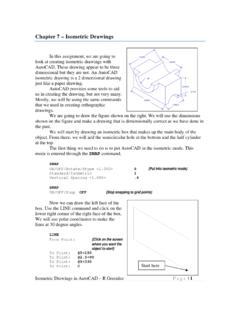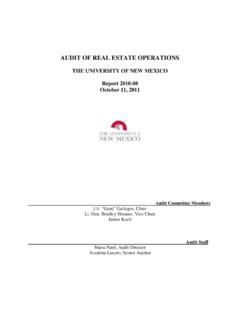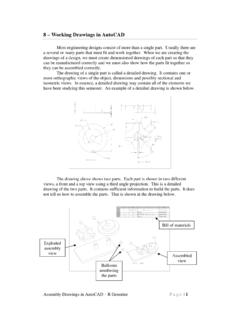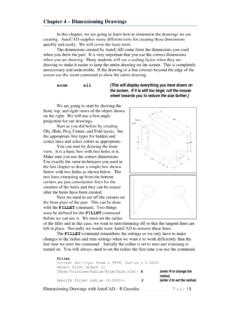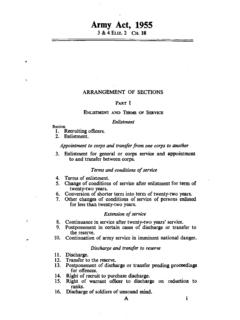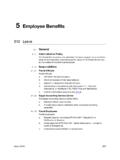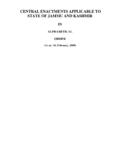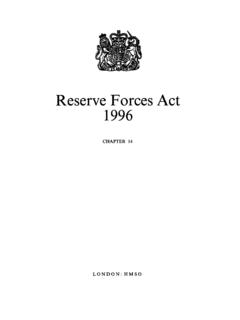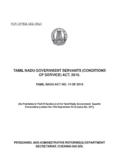Transcription of The Interstate Highway System: 50 Years of Perspective ...
1 Interstate Highway system : 50 years of PerspectiveJerome Hall and Loretta HallOn June 29, 1956, President Dwight Eisenhower signed historic legislation that authorized constructionof the Interstate Highway system and created a pay-as-you-go Highway Trust Fund to generate thefederal government s 90+ percent share of the system s cost. Although Eisenhower is justifiably creditedwith making it a reality, the Interstate system is actually the result of a series of concepts that wererefined over several prior decades within the engineering and political arenas. Developing the systemrequired a visionary financing strategy that would satisfy diverse philosophical and economic viewpoints. Designing the system presented unprecedented challenges for standardizing elements that wouldimprove safety and be appropriate for a truly national Highway system . The current 46,700-mile InterstateSystem generated transportation efficiencies and enabled societal mobility to unanticipated degrees.
2 Thispaper traces the system s conceptual development; describes its major political, societal, financial, andtechnical challenges; and evaluates its influences on the American way of DevelopmentThe federal government undertook its first Interstate road building project in 1806, when it authorizedfederally funded construction of the National Road (now US 40). President Thomas Jefferson approvedlegislation to build the 20-foot-wide Highway on 60-foot-wide right-of-way. The War of 1812 slowedconstruction of the first section from Cumberland, Maryland, to the Ohio River. After spirited debateabout federal versus state powers, the federal government transferred ownership of the road to the statesabout National Road was a macadam Highway traversed by herded livestock and covered wagons. Theintroduction of automobiles to America in the 1890s changed the country s road requirements.
3 Prominentindividuals and new organizations began to promote Interstate roadways. The American Road Makers,which eventually evolved into the American Road and Transportation Builders Association (ARTBA),was founded in 1902 to promote development of a Capital Connecting Government Highway that wouldlink all state capitals with each other and with the national capitol. A 1913 Road Maker Magazine articlesuggested that the 18,000-mile-long, 16-foot-wide Proposed Interstate Highway system be paid for bya tobacco of the most visionary and successful transcontinental highways was developed by the LincolnHighway Association (LHA). The LHA was organized in 1912 by Carl Fisher, who had just built theIndianapolis Motor Speedway. Using private and corporate donations, it strung together existing roadswith some new sections to create a 3,385-mile route between New York City and San Francisco.
4 Amongthe donors were Theodore Roosevelt, Thomas Edison, and Woodrow Wilson but not Henry Ford, whobelieved that the nation s roads should be built by the government, not individuals or companies. TheLHA continued to pursue its goal of creating a coast-to-coast rock Highway until the Lincoln Highway was taking shape, the federal government began re-establishing its role withrespect to the nation s road systems. The Federal Aid Road Act of 1916 authorized $75 million inmatching funds over five Years for Highway construction, but only for states with an appropriate highwaydepartment. The Federal-Aid Highway Act of 1921 upped the federal government s ante to $75,000,000annually and requested that states identify 3 percent of their primary roads as being Interstate incharacter, ensuring they connected with routes in adjacent states. In 1926, the federal governmentpromulgated a national system of numbering these Interstate s six proposed superhighwaysPublic and political momentum for a better Interstate Highway system continued to build over the nextdecade.
5 Highway engineer and historian Lee Mertz wrote that A search of the records of the dayconfirms that the idea of superhighways spanning the nation had caught the fancy of the press, thePresident, the Congress and perhaps the public..At least a dozen bills and resolutions wereintroduced in the Congress between 1936 and early1938 and at least two hearings were held. PresidentFranklin Roosevelt was actively involved in thisprocess, proposing a grid of three north-south andthree east-west super highways spanning thecountry. In the Federal Highway Act of 1938,Congress directed the Bureau of Public Roads(BPR) to investigate the feasibility of such asystem. Toll Roads and Free Roads, the BPR s1939 report, recommended a 26,700-mile system ,saying, Although .. they would represent as asystem less than 1 percent of the total rural highwaymileage of the country, they would unquestionablyaccommodate at least percent of the total rural[vehicle-miles of travel].
6 The Federal-Aid Highway Act of 1944 authorized the designation of a 40,000-mile National system ofInterstate Highways connecting major cities. Progress was slow because of financial and politicalaftermath of World War II and the Korean Conflict. Pushing forward with the effort, prodding Congressto develop a funding mechanism, and getting construction underway were the accomplishments thatearned Eisenhower the unofficial title Father of the Interstate system (officially, the system wasdesignated the Dwight D. Eisenhower system of Interstate and Defense Highways in 1990).Political ChallengesEisenhower became President in 1953, bringing with him two powerful experiences that motivated hisdedication to create an Interstate Highway system . One was his participation in a 1919 military truckconvoy that traveled from Washington, DC, to San Francisco, primarily on the Lincoln Highway .
7 Eighty-one vehicles and 300 Army personnel took 62 days to travel 3,250 miles, hampered both by mechanicalbreakdowns and inadequate roads and bridges. Years later, Eisenhower used the far superior Autobahn tomove troops and equipment during the Allied invasion of of the importance of building a high-quality Interstate Highway system in the United States,Eisenhower began working to gain the cooperation of Congress, state governments, industry and userassociations, and the public at large. He faced two political issues that had hampered development of aninterstate Highway system for decades: reluctance of states to relinquish control over the location anddesign of the roads, and disparate views of the appropriate method and apportionment of s strategy began with enlisting public support for the Interstate Highway system . His firstmajor statement was an address to the 1954 Governors Conference.
8 The speech, actually delivered byVice President Nixon, relayed Eisenhower s assessment that the nation s obsolete Highway network wasimposing five penalties, which no doubt rang true with the public. He compared the annual death andinjury toll to the casualties of a bloody war, noting that nearly 40,000 people were killed and more million were injured annually on the nation s highways. He listed the waste of billions of dollars indetours and traffic jams, the clogging of the nations courts with Highway related suits, and inefficiency Interstate Highway system , 1958the transportation of goods. Finally, he deplored the appalling inadequacies to meet the demands ofcatastrophe or defense should an atomic war come. In the end, he appealed to the governors to help solvethis problem by studying the issue and recommending to him a plan for cooperative action betweenfederal government and the next step in Eisenhower s strategy was to form the President s Advisory Committee on a NationalHighway Program (popularly known as the Clay Committee after it s chairman).
9 Lucius Clay describedits mission as figuring out how we may get[ Highway improvements] quickly, economically, andhow they may be financed sensibly and withinreason. In 1955, Eisenhower asked Congress toapprove the committee s recommendation. Althoughthe Clay Committee s plan was rejected by Congress,it did stimulate the introduction of several alternativeplans that differed primarily in the methods ofgenerating and apportioning funds. Ultimately,Congress approved the Federal-Aid Highway Act of1956, which authorized and funded the NationalSystem of Interstate and Defense proceeded quickly; more than half ofthe new Interstate Highway mileage was built , Eisenhower was substantively unaware of a key tactic in getting Congressional approval forthe Interstate system . In 1955, the BPR prepared and distributed to all members of Congress a 100-pagedocument titled General Location of National system of Interstate Highways but commonly referred to asthe Yellow Book.
10 The book, which showed 122 urban Interstate routes proposed for cities in 43 states, wasinstrumental in convincing legislators of the system s value to their constituents. Eisenhower had beentold that the book documented the legislative history of the Interstate system , and he did not read he did learn of the substantial investment in urban Interstate mileage in 1959, it was too late torecast the system into his original vision of a primarily rural system . The urban portions represented only13 percent of the 41,000-mile system , but they would account for 50 percent of the total ChallengesInclusion of urban Interstate highways was not a new idea. In 1939, for example, Toll Roads and FreeRoads observed that bypass routes are of advantage mainly to a relatively small part of the highwaytraffic normally approaching a city, while the greater part of the heavy traffic at a city entrance is an in-and-out movement of local generation.

